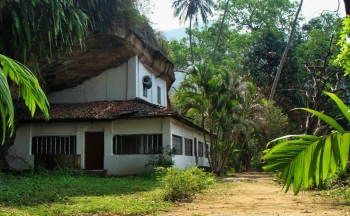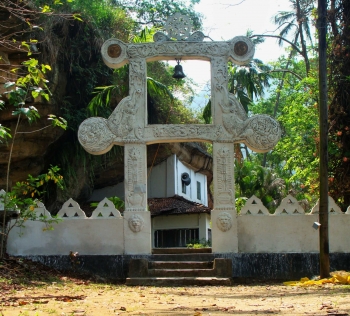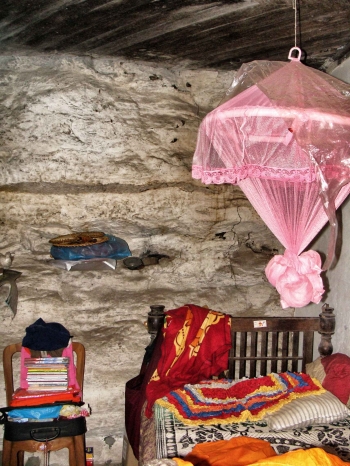A short fifteen minute walk reveals the entrance to the ancient cave temple of Malwela in a shoe shaped mountain known locally as the Bible Rock. Mawela Cave Temple has a long history. King Walagamba ruled the kingdom of Anuradhapura once in 103 BCE and again for 12 years between 89 BCE – 77 BCE. According to archaeological studies, the temple dates back to 103 BCE when King Walagamba took refuge to remain hidden from the Indian invaders who occupied his kingdom four months after his accession.
It is assumed that Mawela Temple and its adjoining caves were meant to house the meditating monks. However, H.C. P. Bell (1851 – 1937), a British civil servant and a commissioner in the Ceylon Civil Service concluded in a 1904 report that this cave temple was built by King Parakramabahu VI during 1400s. Unfortunately his studies remain inconclusive.
The temple lands consist of five caves of which two of them are in a deteriorated state claimed by the jungle. The cave closest to the entrance of the temple houses a mini stupa 11 feet and 6 inches in height. According to local folklore, the mini-stupa encloses the jewelry of a princess. From an archaeological point of view, such stupas built in the interior of buildings are rare in Sri Lanka. This provides a mature ground for further studies.
About 200 meters from the first cave building lies the second cave which houses a reclining Buddha statue with a length of 36 feet. The statue seems to bear characteristics of the Kandyan era and we can still see the original yellow shade of the robes while the surrounding walls and ceilings are decorated with fresco paintings of deities and enlightened monks. Sadly, it is apparent that the natural elements caused much deterioration and preventive measures need implementation.
Folk legends about hidden treasures have unfortunately attracted much strife. Treasure thieves attacked the giant reclining Buddha statue in 1998, 2001 and 2002 which in turn sustained heavy damage. Ironically, the incidents also gave rise to another folktale which chronicles the deaths of treasure hunters cursed by the temple itself. Luckily, the sustained damage has been repaired by the the Archaeological Department of Sri Lanka. K. M. Maydunne, a frequent visitor to the temple, shared his thoughts.
“I hope the authorities would use the existing technologies as CCTV cameras to prevent further defilements by thieves and treasure hunters. It is imperative that we safeguard places like this for the future generations.”
The small bedroom and the kitchen situated inside the third cave are the living quarters of Rev. Senpathigama Dhammarathana who takes care of the temple. The chief prelate Rev. Amunugama Rajaguru Vipassi handles the temple’s administration and visits a few times a month while daily operations, rituals and communal duties of the village temple are executed by Rev. Dhammarathana.
“The times are different now,’ he claims with a smile. “In the past the temple had in its possession around 50 acres of land and we were self-sufficient. But now we only have 4 or 5 acres left as the neighboring villages have claimed the temple lands as their own. We had ample paddy lands and crops gaining an abundant yield. Unfortunately, at present we almost gain nothing out of the lands and we have to rely on donated money and goods.”
In 2006, Mawela Temple was given protection under the antiquities ordinance of Sri Lanka. The Department of Archaeology has repaired the roofs of all three caves, repaired the damage and conducted a number of historical studies. However, there is much more to be accomplished according to Rev. Dhammarathana. It is apparent that the temple still holds the attention and interest of the local community. While it holds on to a past that goes beyond thousands of years, it also claims the right to be relevant to the community in the present and future.
Sean Mós is Sri Lankan Correspondent for Buddhistdoor International. Contact him at palitha007@gmail.com or +94718501577




















